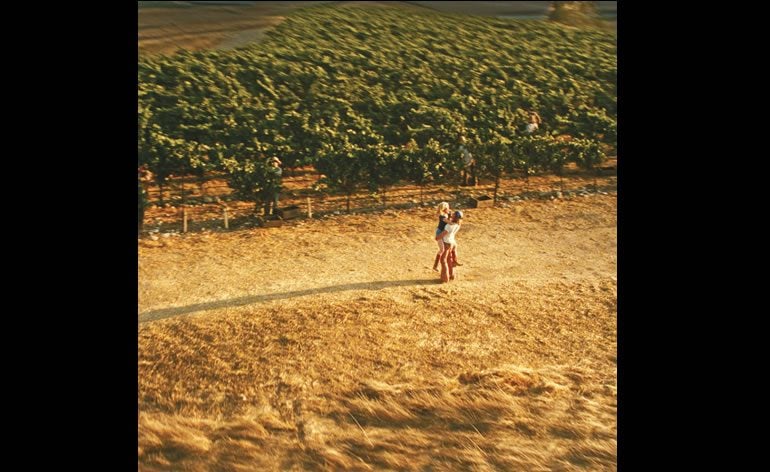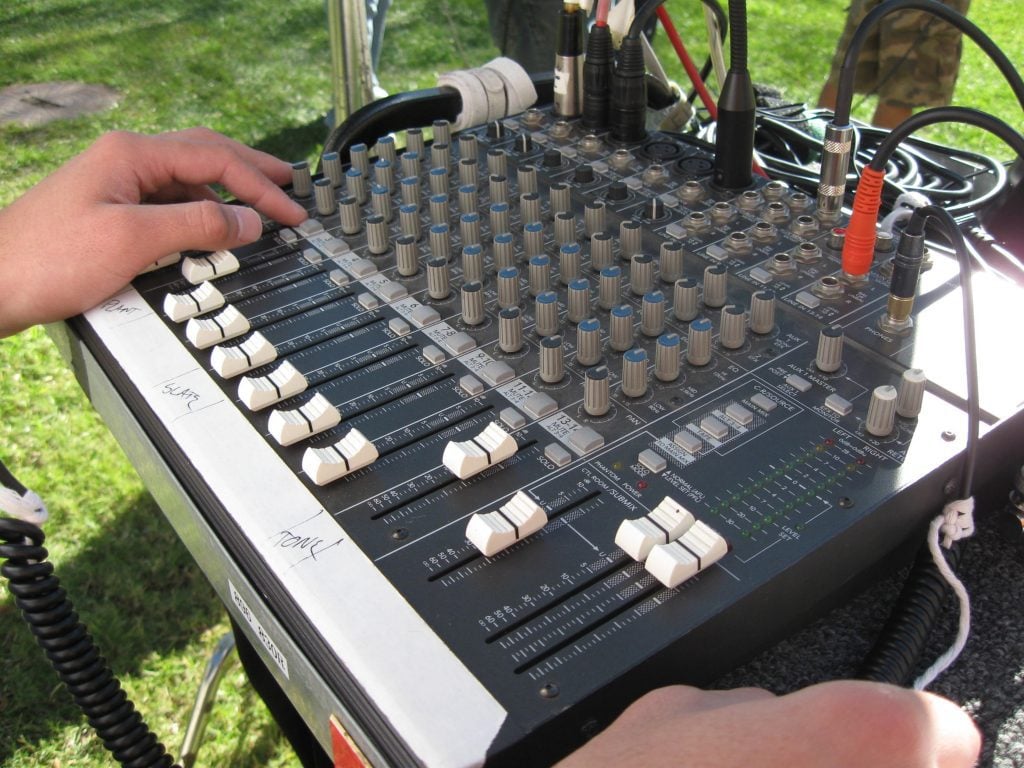Reference: StudentFilmmakers Magazine, April 2008. Bottle Shock: Independent Spirit in Full Bloom by Mary Ann Skweres. Pages 26 – 31.
A bird’s eye view flying over a sea of vines, cresting verdant hills – from that first shot, it is evident that the land is a powerful character in director Randall Miller’s character-based recounting of the turning point in California winemaking. Commenting on that opening, Miller shares, “The image speaks to how far the California wine industry has come. Before this event happened, 4% of the wine consumption in the states was California wines, now it’s over 90%. This moment triggered everything.”
Miller and co-writer/producer Jody Savin, a husband and wife team, began working together when he was in the directing program and she was in the writing/producing program at the American Film Institute. She assisted him on his short thesis film, Marilyn Hotchkiss’ Ballroom Dancing & Charm School. The film won numerous awards and jump-started Miller’s professional career as a director on studio features and television series.
When they first started writing, they worked separately, but as Savin explains, “We would work so much on each other’s stuff, that it was very unsatisfying, so early on we decided to write together.” This segued into her production managing and producing. “We’re both doers. If we can do it ourselves, we do it,” continues Savin. “I got involved because we were writing together and I was always around. Often there is not a producer in the trenches who can solve technical problems.” Under their production banner Unclaimed Freight Productions, the couple has co-written and produced the feature version of Marilyn Hotchkiss’ Ballroom Dancing & Charm School (2005) that premiered at Sundance and Nobel Son, which is scheduled for an April 2008 release.
Marc and Brenda Lhormer, the runners of the Sonoma Film Festival, and also producers on the film, gave the script for Bottle Shock to Miller after screening one of his films at the festival. The original screenplay, written by Ross Schwartz, delved into the lives of a number of the regional vintners. Although the idea was good, the script needed work, mainly to limit the number of subplots, deepen the narrative and write great characters to attract key cast. “A good story is always about the characters,” shares Savin. “The minute we met Jim and Bo Barrett, we knew these guys were great. The whole notion of risking something in pursuit of a dream appealed to us, because we had done something similar when we decided to make our first independent film.” Miller adds, “For us the most interesting and most tangible idea for an audience was the father-son story with this intruder coming in. If there are too many threads, you are not vested enough in any one part.”
Although they usually work on their own material, the filmmaking team rewrote the story in a few months. “We hammer out the whole story in great detail before we write. Then one of us writes a draft,” explains Savin. “The other one then tears it to shreds and we go to a coffee shop and battle it out until we reach a common understanding.” Miller comments, “You can’t raise your voice too high in a coffee shop. It’s a process and we’ve learned it. We never really stop working. We love this.” To get to the heart of the subject matter, Miller and Savin made themselves into experts, gathering information with the help of the Barretts and serious wine aficionado friends. They scoured trade journals and papers of the period and interviewed local vintners including the Barretts and Gustavo Brambila. They flew up and toured Sonoma.
They set the story against a history changing moment – the now infamous, blind Paris wine tasting of 1976, which pitted the best French and Northern California wines against each other. The French went into that tasting as presumed winners based on the standing belief that great wine could only be cultivated in French wine country, but the event turned the international wine world on its head when the American wines took top honors. Miller and Savin could have told the story in numerous ways, but grounded the film on the universally accessible family relationship between young Bo Barrett (Chris Pine), whose undisciplined passion for life keeps him in conflict with his driven father, Jim Barrett (Bill Pullman), whose passion is to create a handcrafted Chardonnay that would rival its French counterpart.
The contentious relationship continues even to this day, as Miller reveals in an example of how the elder Barrett, at 81 years of age, is still a strong force in the life of his son, now in his 50’s. After screening the completed film for Bo, Miller received a call from Jim asking to see the film. “He came down with Bo, but Bo didn’t tell him that he had seen it.” says Miller. “It wasn’t that he thought it was bad. He really liked it. He was worried that if his dad knew that he saw it first, he would be mad at him, or something. So all the conflict is still going on.”
To the creative mix, Miller and Savin added the parallel story of Steven Spurrier, a British wine shop owner in Paris (Alan Rickman), who instigated the contest as a publicity stunt in his own passionate quest to be accepted into the snooty club of French wine connoisseurs. Miller and Savin had worked with both Rickman and Pullman on Nobel Son, and designed the roles in Bottle Shock with those actors in mind.
Rickman also liked the “company troupe” idea of working with the same key creatives on multiple projects. On the way he selects his roles, Rickman says he looks for a script with, “Very good writing. You keep turning the pages. If it’s something you’re going to play, you start inhabiting it, in a way. You start seeing the rooms, what he had for breakfast.” Although an indie film might have less time and coverage than a studio feature, as for his acting, Rickman says, “To be honest, you’re the same instrument walking onto a film set.”
For Rickman, his preparation for every job is different. For Bottle Shock, he had to decide what kind of Englishman the character was. “I talked to the real Steven Spurrier on the phone. You get a very definite picture from that,” reveals Rickman. “A particular energy is what you’re trying to find. Some people are crisper than others. Some people use different language than others. It’s physical, not just what’s coming out of your mouth. It inhabits you from head to foot. Also as an actor, you do hard work, but it’s also about instinct. So you’re an animal.” He recognized a different voice off the page when he read the script. “It was an upper class English accent that I don’t have. You have to access it, because a certain arrogance comes with it.”
Because Miller and Savin like to work with the same talent behind the camera, making a movie is a chance to see all their friends again. “We very much value what our crew does. They’re all artists. The collaboration goes from top to bottom,” says Savin. “We met our DP in film school [AFI], so we’ve been together twenty years.” Cinematographer Mike Ozier masterfully captures the scope and natural beauty of Calistoga, Glen Ellen, Sonoma, and Napa, California. Ozier shot Miller’s thesis film, Marilyn Hotchkiss Ballroom Dancing & Charm School, which was later made into a feature. The team has collaborated on numerous projects. “We bounce ideas off each other,” says Miller.
“When we had a draft that we thought was close, before we’d show the actors, we’d show him. What we were trying to do more than anything else in this movie was to shoot in the vineyards…because it’s a character.”
Miller tries to shot list the whole film before production commences. “Mike and I know each other so well, we talk about things in the abstract. We talk about movies, about specific shots in movies. On this one we talked about A River Runs Through It, Under the Tuscan Sun and other movies. The Natural has beautiful golden light, backlighting, shafts of light.” Miller and Ozier used that look in Bottle Shock.
For the romantic tryst between Gustavo (Freddy Rodriguez) and Sam (Rachel Taylor), Miller staged the scene on a vine-less crest of the rolling vineyards that was covered in golden grasses and had breathtaking 360-degree views.
“We built this shack with the barn doors that totally opened because we were trying to show the world. We were trying to give you the feel, the sweep, “ says Miller. He came across the location on a scout with his second time collaborator, production designer, Craig Stearns. They both knew immediately that this was the location. Stearns built the shack, transforming the visually stunning location into an ideal set for the intimate, yet revealing scene.
“He’s slums when he works with us,” Miller comments about Sterns. “He usually does bigger movies. He actually does the drafting. He uses computer software so when he designs, he actually knows the dimensions and specs of things like windows and doors. He’s very technical as well. It helps efficiency and budget.” Sterns was hired out of Los Angeles, but the art department crew under him came from San Francisco, including set decorator, Barbara Munch, who found all the period “stuff” for the film.
Because the story centered on the Barrett’s, their vineyard Chateau Montelena, was secured as a location. They also shot at Buena Vista Winery and Kunde. Sets were built for the Montelena office and the Paris wine shop. A painted backdrop of the Paris locale was used outside the window. For the shop exterior Miller reveals, “We dressed the town square in Sonoma and digitally put in a still from Paris using After Effects which was later enhanced by the lab. Selling it is all about the cars and the sound effects.” Because Sonoma is an upscale area, permission to film in the town posed a challenge. “Do they really need a film here,” questions Miller. “Not really. They embraced it when they got to know what the film was about.”
For his trip around Sonoma, Rickman drives a classic seventies car. “He’s in a Gremlin,” says Miller. “ He was there for a couple of months, so he would have rented an Ugly Duckling rental car, not a Hertz.” Rickman’s most memorable moment on set had to do with that car. “There’s one bit, that of course, I won’t forget, because at the time I thought, ‘I know he [Miller] is going to use this.’ It was when I kicked the car and accidentally fell over. I really hurt myself. The trained actor that I am…I carried on rather than crying. I didn’t want to cut the shot. It was a complete piece of truth. There was no faking.”
Miller tells his side of that story, “It was funny. He did five or six takes. He slips and falls, then gets up. He’s obviously in pain and says, ‘You’re not going to use that, are you?’ I said, ‘I’m not going to use it.’ Then, before we got here I said, ‘I have to tell you one thing. Remember that take when you fell down? That’s in the movie.’”
Pre-production began in June of 2007, filming began on August 1st and wrapped seven weeks later on September 17th. Miller, who edits his own films, especially loves the time after shooting when all the footage is in the can and he can “start noodling. When you put it together and it seamlessly works.” He is relentless about pacing and admits he is ruthless in cutting whole scenes if it helps the film.
So they could meet the Sundance Film Festival deadline for a completed film by January, Miller promoted Dan O’Brien, a commercial editor who has assisted him on the last two movies, to editor. When they applied for the festival, “We gave Sundance the rough cut. Then we had to finish the movie,” explains Miller. Both editors had Final Cut Pro set-ups with all the media. O’Brien was set-up in Los Angeles. Miller had his system on location. They edited in DV HD codec and would send updated projects back and forth over Apple iDisk. “We know each other really well because we have done a couple of movies, so we didn’t spend a lot of time together,” says Miller.
Drives with the dailies would be sent first to O’Brien, who copied the material onto his drives, then sent them on to Miller, who was cutting in the evenings during production. “I knew I had this time crunch. I actually went back and shot a couple of scenes after I cut it together. We tried to shoot a lot of times between 3 and 6 pm, during ‘Golden Hour.’ It becomes evident when you start putting together a scene when a piece is never going to look right lighting-wise. You’re there in the vineyards, so why not reshoot it?”
The project was shot on 3-perf, super 35 mm matted for 2:35, which allowed for the various aspect ratios needed for distribution without the necessity to pan and scan. Fotokem processed the negative dailies, which the Post Group telecined and digitized. Using 3-perf requires either an optical or DI finish, which is what Miller opted for on Bottle Shock.
Seminal songs by the Doobie Brothers and other seventies bands add an authentic dimension to the picture while complimenting composer Mark Adler’s orchestral score. “We have done five movies with him,” says Miller. “He is a phenomenal composer, but he also has a good sense of music because he was a music editor. On this movie we wanted to create a score that would fit in with the period stuff…but also try to speak to the earth with an almost Appalachian, folk feel.”
Miller always works with the same sound re-recording mixers, Kevin Burns and Todd Orr, but it was the first time collaborating with production sound mixer, Nelson Stoll, who Miller says, “Did a really extraordinary job. There was very little looping.” Kelly Oxford of Sound Deluxe was the supervising sound editor and has done Miller’s last three movies. “He also slums with us,” says Miller. “It’s really not about money. It’s about making good movies. That’s why Alan does it. He does it for the quality.”
Rickman concludes, “I’m proud to have this film here at Sundance. It’s a film I love. It’s absolutely about the independent spirit that Randy and Jody have…in the way they put their films together, the people they attract to work on it, the atmosphere on the set. Then here it is at the festival being celebrated. I think that’s great.”
Mary Ann Skweres is an award-winning independent writer/director with over a dozen produced short films under her belt. A member of the Editor’s Guild, she has edited feature films, documentaries and shorts. She writes about the art and craft of filmmaking for magazines including Below the Line, Film and Video, VFX World and Animation World Network. She can be reached at [email protected].





